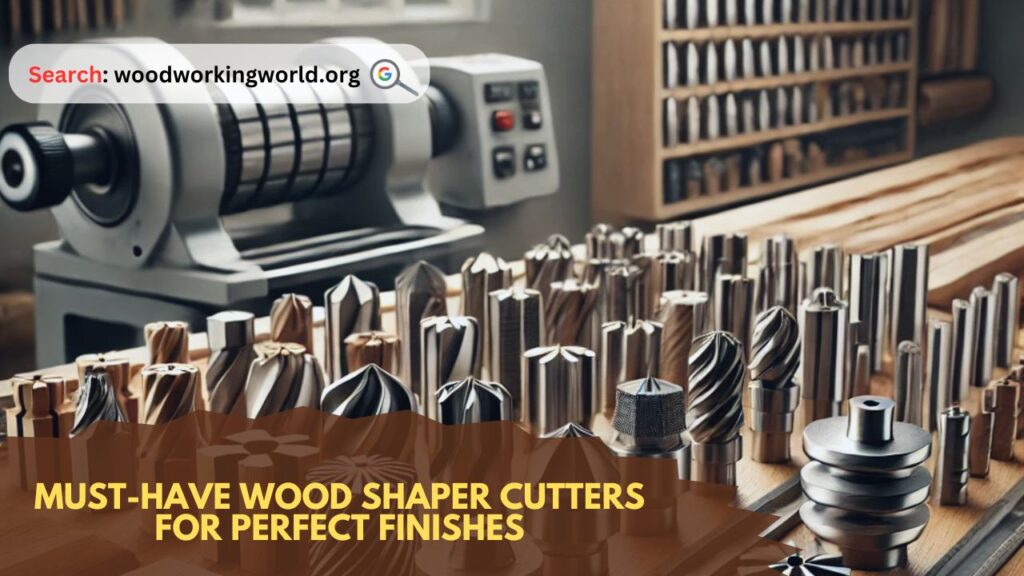Must-Have Wood Shaper Cutters for Perfect Finishes
Wood shaper cutters are essential tools for achieving precise and professional finishes in woodworking projects. Whether you’re crafting intricate moldings, decorative edges, or seamless joinery, the right cutter can make all the difference. This guide covers the must-have wood shaper cutters for your workshop, helping you achieve perfect finishes with ease.

What Are Wood Shaper Cutters?
Wood shaper cutters are specialized cutting tools mounted on wood shapers to shape and profile wood surfaces. These cutters come in various shapes, sizes, and configurations, each designed for specific tasks.
Key Features of Shaper Cutters:
- Durability: Typically made from high-quality steel or carbide for long-lasting performance.
- Versatility: Suitable for creating various wood profiles and designs.
- Precision: Provide clean and accurate cuts for professional results.
Pro Tip: Invest in carbide-tipped cutters for longer-lasting sharpness and better performance on hardwoods.
Must-Have Wood Shaper Cutters
1. Straight Cutters
Straight cutters are versatile tools used for basic shaping, edge trimming, and creating straight grooves.
Best For:
- Creating dadoes and grooves
- Trimming edges
- Flattening surfaces
Why You Need It:
A straight cutter is a staple in any woodworking shop for its wide range of applications.
2. Profile Cutters
Profile cutters are designed to create decorative edges and intricate patterns.
Best For:
- Crown moldings
- Cabinet edges
- Furniture detailing
Why You Need It:
These cutters add a professional touch to your woodworking projects.
3. Tongue and Groove Cutters
Tongue and groove cutters are essential for creating strong and precise joinery.
Best For:
- Flooring
- Paneling
- Cabinet doors
Why You Need It:
They ensure tight and secure joints for durable assemblies.
4. Bead Cutters
Bead cutters create rounded decorative edges and grooves.
Best For:
- Furniture detailing
- Trim work
- Decorative panels
Why You Need It:
These cutters add elegance and visual interest to your projects.
5. Raised Panel Cutters
Raised panel cutters are used to create stylish and sophisticated panel designs.
Best For:
- Cabinet doors
- Decorative wall panels
Why You Need It:
They provide a polished and professional look to cabinetry and paneling.
Start Your Next Project With Teds’ Archive Of 16,000 Plans!
Instant access to all 16,000 woodworking plans with step-by-step details, photos, materials lists and more
Monthly free plans with lifetime membership access – No renewals, recurring fees or other charges


6. Cove Cutters
Cove cutters create concave profiles for decorative edges.
Best For:
- Furniture edges
- Molding accents
Why You Need It:
Cove cutters add depth and dimension to your woodworking projects.
7. Chamfer Cutters
Chamfer cutters are used to create beveled edges.
Best For:
- Decorative edges
- Joinery preparation
Why You Need It:
They provide clean and angled cuts, enhancing the aesthetics and functionality of your work.
Choosing the Right Wood Shaper Cutters
1. Material:
- Carbide-Tipped: Best for hardwoods and long-lasting performance.
- High-Speed Steel (HSS): Suitable for softwoods and budget-friendly options.
2. Cutter Size:
- Choose the appropriate size based on your project requirements and wood shaper capacity.
3. Cutter Profile:
- Select profiles that match your desired design and woodworking tasks.
4. Compatibility:
- Ensure the cutters are compatible with your wood shaper model.
Pro Tip: Keep a variety of cutter profiles on hand to handle different projects efficiently.
Maintenance Tips for Wood Shaper Cutters
- Clean After Use: Remove sawdust and resin buildup to maintain sharpness.
- Sharpen Regularly: Keep cutters sharp for cleaner cuts and longer life.
- Store Properly: Use protective cases or racks to prevent damage.
- Inspect for Damage: Check for chips or cracks before use.
Maintenance Tip: Use a professional sharpening service for carbide-tipped cutters to maintain their precision.
Safety Tips for Using Wood Shaper Cutters
- Wear Safety Gear: Always use goggles, ear protection, and a dust mask.
- Secure the Workpiece: Use clamps or feather boards to hold the wood firmly.
- Check Cutter Installation: Ensure the cutter is securely mounted and balanced.
- Feed Wood Correctly: Always feed against the cutter rotation.
- Keep Hands Clear: Use push blocks to keep your hands away from the cutter.
FAQs
1. What is the difference between router bits and wood shaper cutters?
Router bits are smaller and designed for handheld routers, while wood shaper cutters are larger and intended for heavy-duty shaping tasks on wood shapers.
2. Can I use wood shaper cutters on a router table?
In some cases, yes, but it’s not recommended due to size and power differences between the two machines.
3. How do I maintain the sharpness of my wood shaper cutters?
Clean them regularly, store them properly, and sharpen them as needed.
4. What materials can I shape with wood shaper cutters?
Wood shaper cutters are primarily designed for wood but can also handle composite materials.
5. How do I choose the right cutter profile?
Consider your project requirements and design preferences when selecting cutter profiles.
Video from a woodworking expert

Conclusion
Having the right wood shaper cutters in your workshop can make all the difference in achieving perfect finishes and professional results. From straight cutters for basic tasks to profile and raised panel cutters for decorative details, investing in high-quality cutters will elevate your woodworking projects. Upgrade your workshop today with these must-have wood shaper cutters and experience the difference in your craftsmanship.